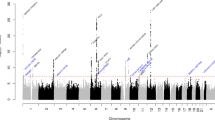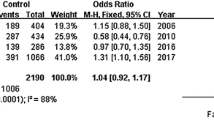Abstract
While migraine has been demonstrated to be familial and have genetic contributions, genome-wide linkage analyses and candidate gene studies have highlighted that migraine is genetically complex. Despite substantial efforts, no consistent replication of linkage or association has been reported for common migraine syndromes. Among the candidate genes tested for association with migraine by several groups were female sex hormone genes based on the observation of a much higher incidence of migraine in females. Migraine-associated vertigo (MAV) is a migraine syndrome also much more common in females than males. Because MAV is less common in the general population than migraine or migraine with aura, it may be a better migraine syndrome to detect susceptibility alleles. In this study, we tested the association of two female hormonal genes, progesterone receptor (PGR) and estrogen receptor (ESR1), which were previously reported to be associated with migraine in women. We typed 150 MAV subjects and 145 genomic matched control subjects. One SNP (rs1042838) within PGR, which is in high linkage disequilibrium with the functional PROGINS variant, was significantly associated with MAV (p = 0.0007). Two SNPs (rs2228480 and rs1801132) within ESR1 demonstrated no significant association. No synergistic effect between ESR1 variants and PGR variants was identified.
Similar content being viewed by others
Reference
Stewart WF, Bigal ME, Kolodner K, Dowson A, Liberman JN, Lipton RB (2006) Familial risk of migraine: variation by proband age at onset and headache severity. Neurology 66:344–348
Stewart WF, Staffa J, Lipton RB, Ottman R (1997) Familial risk of migraine: a population-based study. Ann Neurol 41:166–172
Stewart WF, Lipton RB, Celentano DD, Reed ML (1992) Prevalence of migraine headache in the United States. Relation to age, income, race, and other sociodemographic factors. JAMA 267:64–69
Sheffield RE (1998) Migraine prevalence: a literature review. Headache 38:595–601
Rasmussen BK, Olesen J (1992) Migraine with aura and migraine without aura: an epidemiological study. Cephalalgia 12:221–228 (discussion 186)
Lipton RB, Stewart WF (1997) Prevalence and impact of migraine. Neurol Clin 15:1–13
Kelman L (2006) Migraine changes with age: IMPACT on migraine classification. Headache 46:1161–1171
De Fusco M, Marconi R, Silvestri L, Atorino L, Rampoldi L, Morgante L, Ballabio A, Aridon P, Casari G (2003) Haploinsufficiency of ATP1A2 encoding the Na+/K+ pump alpha2 subunit associated with familial hemiplegic migraine type 2. Nat Genet 33:192–196
Ophoff RA, Terwindt GM, Vergouwe MN, van Eijk R, Oefner PJ, Hoffman SM, Lamerdin JE, Mohrenweiser HW, Bulman DE, Ferrari M, Haan J, Lindhout D, van Ommen GJ, Hofker MH, Ferrari MD, Frants RR (1996) Familial hemiplegic migraine and episodic ataxia type-2 are caused by mutations in the Ca2+ channel gene CACNL1A4. Cell 87:543–552
Wessman M, Kallela M, Kaunisto MA, Marttila P, Sobel E, Hartiala J, Oswell G, Leal SM, Papp JC, Hamalainen E, Broas P, Joslyn G, Hovatta I, Hiekkalinna T, Kaprio J, Ott J, Cantor RM, Zwart JA, Ilmavirta M, Havanka H, Farkkila M, Peltonen L, Palotie A (2002) A susceptibility locus for migraine with aura, on chromosome 4q24. Am J Hum Genet 70:652–662
Soragna D, Vettori A, Carraro G, Marchioni E, Vazza G, Bellini S, Tupler R, Savoldi F, Mostacciuolo ML (2003) A locus for migraine without aura maps on chromosome 14q21.2–q22.3. Am J Hum Genet 72:161–167
Nyholt DR, Morley KI, Ferreira MA, Medland SE, Boomsma DI, Heath AC, Merikangas KR, Montgomery GW, Martin NG (2005) Genomewide significant linkage to migrainous headache on chromosome 5q21. Am J Hum Genet 77:500–512
Lea RA, Nyholt DR, Curtain RP, Ovcaric M, Sciascia R, Bellis C, Macmillan J, Quinlan S, Gibson RA, McCarthy LC, Riley JH, Smithies YJ, Kinrade S, Griffiths LR (2005) A genome-wide scan provides evidence for loci influencing a severe heritable form of common migraine. Neurogenetics 6:67–72
Carlsson A, Forsgren L, Nylander PO, Hellman U, Forsman-Semb K, Holmgren G, Holmberg D, Holmberg M (2002) Identification of a susceptibility locus for migraine with and without aura on 6p12.2–p21.1. Neurology 59:1804–1807
Cader ZM, Noble-Topham S, Dyment DA, Cherny SS, Brown JD, Rice GP, Ebers GC (2003) Significant linkage to migraine with aura on chromosome 11q24. Hum Mol Genet 12:2511–2517
Bjornsson A, Gudmundsson G, Gudfinnsson E, Hrafnsdottir M, Benedikz J, Skuladottir S, Kristjansson K, Frigge ML, Kong A, Stefansson K, Gulcher JR (2003) Localization of a gene for migraine without aura to chromosome 4q21. Am J Hum Genet 73:986–993
Aragones JM, Fortes-Rego J, Fuste J, Cardozo A (1993) Migraine: an alternative in the diagnosis of unclassified vertigo. Headache 33:125–128
Bayazit Y, Yilmaz M, Mumbuc S, Kanlikama M (2001) Assessment of migraine-related cochleovestibular symptoms. Rev Laryngol Otol Rhinol (Bord) 122:85–88
Brantberg K, Trees N, Baloh RW (2005) Migraine-associated vertigo. Acta Otolaryngol 125:276–279
Cass SP, Furman JM, Ankerstjerne K, Balaban C, Yetiser S, Aydogan B (1997) Migraine-related vestibulopathy. Ann Otol Rhinol Laryngol 106:182–189
Cutrer FM, Baloh RW (1992) Migraine-associated dizziness. Headache 32:300–304
Dieterich M, Brandt T (1999) Episodic vertigo related to migraine (90 cases): vestibular migraine? J Neurol 246:883–892
Kayan A, Hood JD (1984) Neuro-otological manifestations of migraine. Brain 107 (4):1123–1142
Kuritzky A, Ziegler DK, Hassanein R (1981) Vertigo, motion sickness and migraine. Headache 21:227–231
Lanzi G, Balottin U, Fazzi E, Tagliasacchi M, Manfrin M, Mira E (1994) Benign paroxysmal vertigo of childhood: a long-term follow-up. Cephalalgia 14:458–460
Mira E, Piacentino G, Lanzi G, Balottin U, Fazzi E (1984) Benign paroxysmal vertigo in childhood: a migraine equivalent. ORL J Otorhinolaryngol Relat Spec 46:97–104
Moretti G, Manzoni GC, Caffarra P, Parma M (1980) “Benign recurrent vertigo” and its connection with migraine. Headache 20:344–346
Neuhauser H, Leopold M, von Brevern M, Arnold G, Lempert T (2001) The interrelations of migraine, vertigo, and migrainous vertigo. Neurology 56:436–441
Neuhauser HK, Radtke A, von Brevern M, Feldmann M, Lezius F, Ziese T, Lempert T (2006) Migrainous vertigo: prevalence and impact on quality of life. Neurology 67:1028–1033
Savundra PA, Carroll JD, Davies RA, Luxon LM (1997) Migraine-associated vertigo. Cephalalgia 17:505–510 (discussion 487)
Stahl JS, Daroff RB (2001) Time for more attention to migrainous vertigo? Neurology 56:428–429
von Brevern M, Ta N, Shankar A, Wiste A, Siegel A, Radtke A, Sander T, Escayg A (2006) Migrainous vertigo: mutation analysis of the candidate genes CACNA1A, ATP1A2, SCN1A, and CACNB4. Headache 46:1136–1141
Colson NJ, Lea RA, Quinlan S, MacMillan J, Griffiths LR (2005) Investigation of hormone receptor genes in migraine. Neurogenetics 6:17–23
Colson NJ, Lea RA, Quinlan S, MacMillan J, Griffiths LR (2004) The estrogen receptor 1 G594A polymorphism is associated with migraine susceptibility in two independent case/control groups. Neurogenetics 5:129–133
Oterino A, Pascual J, Ruiz de Alegria C, Valle N, Castillo J, Bravo Y, Gonzalez F, Sanchez-Velasco P, Cayon A, Leyva-Cobian F, Alonso-Arranz A, Munoz P (2006) Association of migraine and ESR1 G325C polymorphism. Neuroreport 17:61–64
De Vivo I, Huggins GS, Hankinson SE, Lescault PJ, Boezen M, Colditz GA, Hunter DJ (2002) A functional polymorphism in the promoter of the progesterone receptor gene associated with endometrial cancer risk. Proc Natl Acad Sci USA 99:12263–12268
Pooley KA, Healey CS, Smith PL, Pharoah PD, Thompson D, Tee L, West J, Jordan C, Easton DF, Ponder BA, Dunning AM (2006) Association of the progesterone receptor gene with breast cancer risk: a single-nucleotide polymorphism tagging approach. Cancer Epidemiol Biomarkers Prev 15:675–682
Pearce CL, Hirschhorn JN, Wu AH, Burtt NP, Stram DO, Young S, Kolonel LN, Henderson BE, Altshuler D, Pike MC (2005) Clarifying the PROGINS allele association in ovarian and breast cancer risk: a haplotype-based analysis. J Natl Cancer Inst 97:51–59
Terry KL, De Vivo I, Titus-Ernstoff L, Sluss PM, Cramer DW (2005) Genetic variation in the progesterone receptor gene and ovarian cancer risk. Am J Epidemiol 161:442–451
Curran JE, Lea RA, Rutherford S, Weinstein SR, Griffiths LR (2001) Association of estrogen receptor and glucocorticoid receptor gene polymorphisms with sporadic breast cancer. Int J Cancer 95:271–275
Hsiao WC, Young KC, Lin SL, Lin PW (2004) Estrogen receptor-alpha polymorphism in a Taiwanese clinical breast cancer population: a case-control study. Breast Cancer Res 6:R180–R186
Vasconcelos A, Medeiros R, Veiga I, Pereira D, Carrilho S, Palmeira C, Azevedo C, Lopes CS (2002) Analysis of estrogen receptor polymorphism in codon 325 by PCR-SSCP in breast cancer: association with lymph node metastasis. Breast J 8:226–229
Fan JB, Chee MS, Gunderson KL (2006) Highly parallel genomic assays. Nat Rev Genet 7:632–644
Nielsen DM, Ehm MG, Weir BS (1998) Detecting marker-disease association by testing for Hardy–Weinberg disequilibrium at a marker locus. Am J Hum Genet 63:1531–1540
Moskvina V, Holmans P, Schmidt KM, Craddock N (2005) Design of case-controls studies with unscreened controls. Ann Hum Genet 69:566–576
Colson NJ, Lea RA, Quinlan S, Griffiths LR (2006) No role for estrogen receptor 1 gene intron 1 Pvu II and exon 4 C325G polymorphisms in migraine susceptibility. BMC Med Genet 7:12
Ophoff RA, van Eijk R, Sandkuijl LA, Terwindt GM, Grubben CP, Haan J, Lindhout D, Ferrari MD, Frants RR (1994) Genetic heterogeneity of familial hemiplegic migraine. Genomics 22:21–26
Kallela M, Wessman M, Havanka H, Palotie A, Farkkila M (2001) Familial migraine with and without aura: clinical characteristics and co-occurrence. Eur J Neurol 8:441–449
Oedegaard KJ, Angst J, Neckelmann D, Fasmer OB (2005) Migraine aura without headache compared to migraine with aura in patients with affective disorders. J Headaches Pain 6:378–386
Eriksen MK, Thomsen LL, Olesen J (2006) Implications of clinical subtypes of migraine with aura. Headache 46:286–297
Agoulnik IU, Tong XW, Fischer DC, Korner K, Atkinson NE, Edwards DP, Headon DR, Weigel NL, Kieback DG (2004) A germline variation in the progesterone receptor gene increases transcriptional activity and may modify ovarian cancer risk. J Clin Endocrinol Metab 89:6340–6347
Donaldson CJ, Crapanzano JP, Watson JC, Levine EA, Batzer MA (2002) PROGINS Alu insertion and human genomic diversity. Mutat Res 501:137–141
Sullivan PF (2007) Spurious genetic associations. Biol Psychiatry 61:1121–1126
Kaunisto MA, Kallela M, Hamalainen E, Kilpikari R, Havanka H, Harno H, Nissila M, Sako E, Ilmavirta M, Liukkonen J, Teirmaa H, Tornwall O, Jussila M, Terwilliger J, Farkkila M, Kaprio J, Palotie A, Wessman M (2006) Testing of variants of the MTHFR and ESR1 genes in 1798 Finnish individuals fails to confirm the association with migraine with aura. Cephalalgia 26:1462–1472
Acknowledgement
We are grateful to the patients and their families for participating in this research study. We thank S. L. Stoddart for the sample preparation. Genotyping was performed with the assistance of the UCLA Southern California Genotyping Consortium (SCGC). We thank the members of the Nelson Lab for the guidance and input. This study was supported by a program project grant NIH/NIDCD P50 DC 05224.
Conflict of interest statement
The authors declare no competing interests.
Author information
Authors and Affiliations
Corresponding author
Rights and permissions
About this article
Cite this article
Lee, H., Sininger, L., Jen, J.C. et al. Association of progesterone receptor with migraine-associated vertigo. Neurogenetics 8, 195–200 (2007). https://doi.org/10.1007/s10048-007-0091-3
Received:
Accepted:
Published:
Issue Date:
DOI: https://doi.org/10.1007/s10048-007-0091-3




